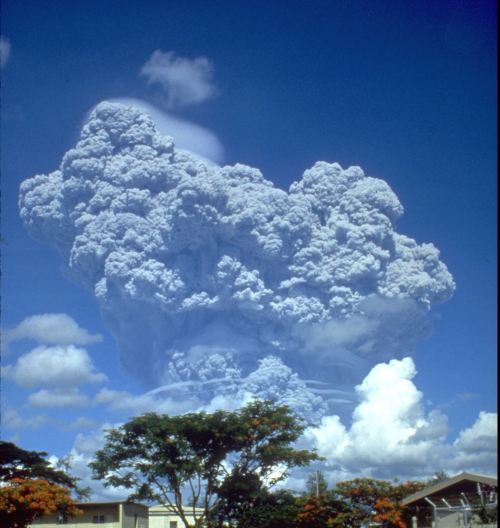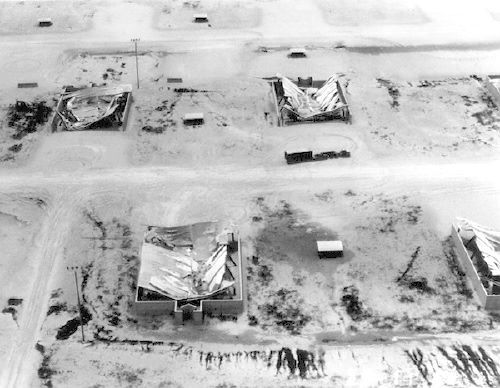Second Largest Volcanic Eruption of the 20th CenturyThis week is the 25th anniversary of both the de
Second Largest Volcanic Eruption of the 20th CenturyThis week is the 25th anniversary of both the devastating Mount Pinatubo eruption, and of Typhoon Yunya hitting the Philippines. These two natural catastrophes struck the densely populated island of Luzon on June 15, 1991.Prior to 1991, Pinatubo was a heavily forested lava dome that had been dormant for 500 years. Little was known about the stratovolcano. When it begin to show signs of life in March of 1991, first with earthquakes rumbling beneath it and then by relatively small ash explosions, scientists had very little information to predict what might happen next. Researchers quickly moved to install seismic monitors and survey the mountain. To their dismay, they discovered Pinatubo had a history of very large eruptions.The mountain and the surrounding area were home to hundreds of thousands of people. An additional 15,000, US military personnel and their families, lived at Clark Air Force base. As seismicity, deformation of the mountain, and emission of small plumes increased, the people living on the mountain and those closest to it were evacuated in stages. Then on June 7, the first magma began to reach the surface. By June 9, over 50,000 locals had been ordered to leave. On June 10, all but 1,500 military personnel and the scientists monitoring Pinatubo were ordered to evacuate Clark.At 8:51am on June 12 (Independence Day in the Philippines), Pinatubo erupted explosively, sending a column of ash and steam 19 kilometers (11 miles) into the air. It subsided after 40 minutes, but the earthquakes didn’t; the mountain wasn’t done. All residents within 20 kilometers of the mountain were told to evacuate. Another 600 at Clark were told to leave as well.The morning of June 15, Typhoon Yunya struck Luzon even as the mountain continued to erupt with smaller explosions. Fortunately the storm was already dissipating into a tropical storm. Even so, it brought heavy rains and circular winds. Then, around 1:42pm local time, Pinatubo exploded with the second largest eruption in the 20th century. The explosion ejected 5 cubic kilometers (1 cubic mile) of material. Much of the mountain summit was removed by explosions or collapse, leaving a caldera 2.5 kilometers (1.6 miles) across. The ash cloud rose 35 kilometers (22 miles) into the air. At lower altitudes, ash that would’ve blown out to sea was caught in Yunya’s circulating winds, and then brought back down on Luzon by the rain. The heavy, wet ash came down like mud and accumulated on rooftops, collapsing many of them. Pumice, including some the size of apricots, began to fall on Clark and the nearby city of Angeles, in some cases causing injuries. Lahars and debris came down the mountain and filled some valleys 200 meters (660 feet) thick. Many people fled and more evacuations were ordered; all together, the eruption dislocated about 250,000 people.Pinatubo continued to erupt for several days, but the worst was over and some people began to return to their homes. Ash continued to erupt and was reported to be 15-30 centimeters thick at Clark and some of the surrounding towns and cities. So much ash was expelled throughout the eruption that it would eventually cause a short-term global cooling of 0.5-degrees Celsius.The eruption finally ended in September. Over 105,000 homes were damaged or destroyed, and the thick layer of ash over once fertile agricultural lands caused long-term hardship. There was so much ash that new lahars formed during monsoon seasons for several years after, in one case killing 60 people. In June of 1992, about 70,000 were still living in evacuation centers and resettlement areas. Clark was permanently abandoned.Amazingly, the death toll was only about 725. The evacuations are believed to have saved the lives of 20,000 people.Pinatubo begin to erupt again in July of 1992 from a caldera lake that now exists where the mountain summit used to be. It erupted again in February of 1993. Fortunately the eruptions were relatively small. The volcano finally went quiet, and, based on past history, probably won’t erupt again for hundreds of years.REPhoto Credit:Richard P. Hoblitt, U.S. Geological Survey, http://bit.ly/1S0AQsaR.S. Culbreth U.S. Air Force, https://www.flickr.com/photos/kyngpao/8874135744/USGS / Cascade Volcano Observatory, http://bit.ly/1rj2sDhE.J. Wolfe, http://bit.ly/1ZHrxU1References: http://pubs.usgs.gov/fs/1997/fs113-97/http://gsabulletin.gsapubs.org/content/117/1-2/195.fullhttp://volcano.si.edu/volcano.cfm?vn=273083http://bit.ly/1tuS3Gohttp://bit.ly/1SkSzjgPrevious Earth Story Posts:http://bit.ly/1UnCM3Shttp://bit.ly/1ufd6VQ -- source link
#pinatubo#philippines#eruption#volcano#history#anniversary#geology#june 15#typhoon#evacuation#caldera#yunya#luzon#pyroclastic#disaster#geohazard



